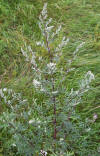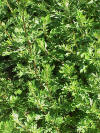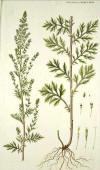WILD
FOODIES' HOME PAGE
PLANT PROFILE LIST
NAME: MUGWORT
SPECIES / FAMILY: Artemisia Vulgaris / Asteraceae or Compositae
COMMON NAME(S):
CONDITIONS: sun, farm fields, urban areas
|
PARTS: |
EDIBLE |
TASTE |
RAW/COOK |
SEASON |
|
All |
|
|
|
|
|
Shoots |
|
sage |
DRY/COOK |
Spring-Fall |
|
Leaves |
|
sage |
DRY/COOK |
Spring-Fall |
|
Buds/Flowers |
|
sage |
DRY/COOK |
Summer-Fall |
|
Fruits |
|
|
|
|
|
Roots |
||||
|
Seeds |
|
|||
|
Nuts |
|
|
|
|
|
Pods |
|
|
|
|
|
Stalk |
|
|
|
|
|
Bark |
|
|
|
|
PORTION: small, herb
COMMENT: Although PFAF.org says it can be eaten raw, perhaps it's safer to use dried or cooked. Used in stews, baked goods, teas, and alcoholic beverages. Tastes like sage. // "METHOD OF PREPARATION: We will let Cornucopia II do that: “young shoots and leaves are an indispensable condiment for fatty poultry such as geese and duck as well as fat pork, mutton, and eel. In Japan they are boiled and eaten as a potherb, or used to give flavor and color to festival rice-cakes… Dried leaves and flowering tops are added to country beer, or seeped into tea. At one time in China the leaves were used for wrapping glutinous rice dumplings eaten during the Dragon Boat Festival.” (2)
CAUTION: Might be poisonous in large doses. Allergic reactions. Skin contact dermatitis in some people. Probably unsafe for pregnant women as it may stimulate the uterus to contract and induce abortion.(1) Exercise caution. I only use it cooked or dried with other foods and in very small amounts, not every day, and not by itself in a tea in the evening. Perhaps the safest way for lucid dreaming is to put dried mugwort in a sachet and breath in the fragrance for a few minutes. Editor
NUTRITION/MEDICINAL:
"Mugwort has a long history of use in herbal medicine
especially in matters connected to the digestive system, menstrual complaints
and the treatment of worms[238]. It is slightly toxic, however, and should
never be used by pregnant women, especially in their first trimester, since it
can cause a miscarriage[7, 238]. Large, prolonged dosage can damage the
nervous system[268]. All parts of the plant are anthelmintic, antiseptic,
antispasmodic, carminative, cholagogue, diaphoretic, digestive, emmenagogue,
expectorant, nervine, purgative, stimulant, slightly tonic and used in the
treatment of women's complaints[4, 7, 13, 21, 147, 165, 178, 201].
ALSO:
https://www.organicfacts.net/health-benefits/herbs-and-spices/mugwort-tea.html
https://herbs-treatandtaste.blogspot.com/2012/07/japanese-mugwort-yomogi-health-benefits.html
Look-A-Likes: Epazote and related to Sweet Annie and Artemisia absinthium (wormwood) is the specific species of artemisia.
POISONOUS LOOK-A-LIKES:
OTHER USES: insect repellent, fragrance, tinder for fires, food for moths & butterflies (1) Studied for use in reclamation and phytoremediation of contaminated soils and waters.-https://www.ncbi.nlm.nih.gov/pubmed/26269111
SOURCE LINKS (may include nutritional and medicinal info, plus other uses):
- https://pfaf.org/user/Plant.aspx?LatinName=Artemisia+vulgaris
- http://www.eattheweeds.com/mugwort
- https://en.wikipedia.org/wiki/Artemisia_vulgaris
- http://www.ediblewildfood.com/mugwort.aspx
- https://www.herbrally.com/monographs/mugwort
- https://www.outdoorapothecary.com/mugwort
- https://www.indigo-herbs.co.uk/natural-health-guide/benefits/mugwort
- https://medium.com/@3LittleBears/mugwort-the-wild-edible-and-recipes-5b3e0f0bc0d0 (recipes)
- https://gathervictoria.com/2017/10/25/foraging-cooking-with-coastal-mugwort-a-salt-honey-vinegar (recipes)
- https://www.backyardforager.com/mugwort-soup-recipe-yes-really (recipes)
- https://www.eatweeds.co.uk/mugwort-jelly-recipe (recipe)
COMPARISON OF DIFFERENT SPECIES OF ARTEMISIA:

https://www.sciencedirect.com/topics/agricultural-and-biological-sciences/artemisia-genus
Fig. 1. Leaves and synflorescences of four Artemisia species. (A) Artemisia absinthium. (B) Artemisia annua (Sweet Annie). (C) Artemisia dracunculus (French Tarragon). (D) (Mugwort) Artemisia vulgaris. For each species, the leaves placed in the upper or left side show the adaxial face and those placed in the lower or right side show the abaxial face. Photographs by P. Barnola, A. Mallol and L. Vilar (synflorescences of A. absinthium—detail—and A. dracunculus), G. Pié (synflorescence of A. annua) and J. Vallès (the rest).





